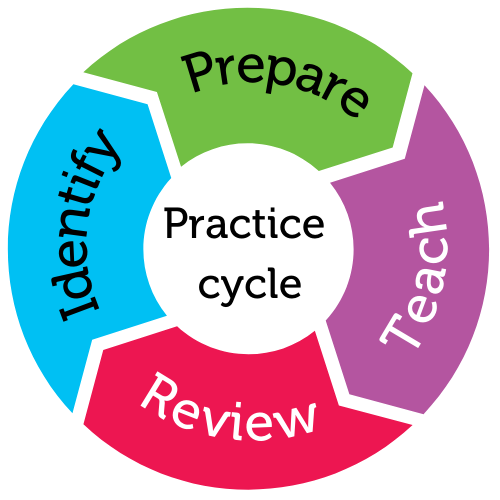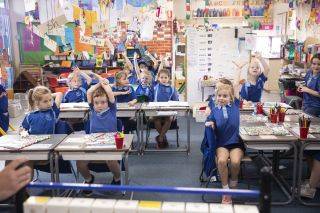
For student year
Helps students to
- be accepted by their peers
- feel supported
Helps teachers to
- understand student needs
- personalise behaviour plans
Summary
Some students may display unproductive or even challenging behaviours which affect their participation in the classroom. In many instances, students are responding to something that has happened or they are trying to get something to happen. Conducting an ABC analysis enables you to understand why and when a behaviour occurs. Analysing and understanding the environmental factors that occur before, during, and after a behaviour is exhibited can help teachers to more effectively manage the classroom and student behaviours.
How this practice works
Watch this video to learn more.
Duration: 3:10
Australian Professional Standards for Teachers related to this practice
4.1 - support student participation
4.3 - manage challenging behaviour
For further information, see Australian Professional Standards for Teachers AITSL page
Preparing to teach
Why use an ABC analysis?
All behaviour is purposeful and communicates a message. In many instances, the purpose of unproductive or challenging behaviour is in response to something that has happened or an attempt to try to get something to happen.
Conducting an ABC analysis will help you to understand the purpose or function of a behaviour of concern or how the behaviour is influenced by environmental factors.
What does ABC mean
- A = Antecedent or trigger. What happens before the behaviour
- B = Behaviour. What the child does
- C = Consequence. What happens after the behaviour
How does it help?
An ABC analysis process enables you to understand why and when a behaviour occurs by collecting data on the behaviour, as well as what happens before and after it occurs.
An ABC (Antecedent, Behaviour, Consequence) approach to analysis of behaviour assists you to:
- identify the specific circumstances that influence a student’s behaviour
- describe the student’s unproductive behaviour in detail
- understand the actions of others (unintended or intended) in response to the behaviour which may encourage the student to continue using the behaviour
Antecedents
- actions of staff and peers
- circumstances that trigger a behaviour
- events in the environment
Consequences (intended and unintended)
- any responses/actions of staff and peers that follow the behaviour
How does it work?
Data is collected on the behaviour, as well as what happens before and after it occurs.
Antecedents
- Antecedents are what come immediately before the behavioural response. Antecedents are the actions, circumstances, or events in the environment that trigger a behaviour.
Behaviour
- Establish what the behavioural response was to the antecedent. Data on the ABC of the behaviour is collected and recorded as soon as practicable after the behaviour has occurred.
- Once you have data spanning multiple occurrences, times, and settings (where possible) has been collected, it should be reviewed and any patterns noted. These patterns can be used to work out the purpose of the behaviour. The purpose of the behaviour can be to communicate or to avoid or obtain something (activity, attention, object).
Consequence
- Once the purpose of the behaviour is known, the environment can be adjusted with the aim of addressing students’ needs, thereby reducing the likelihood of the behaviour and allowing for the teaching of a more productive alternative /replacement behaviour.
NB: As you choose strategies to respond to behaviour, always refer to the student behaviour policy and guidelines within the relevant state or school system.
The collection of data
Data collection is an essential part of the analysis process. Data is collected on the identified behaviour, as well as on what happens before (antecedent or trigger) and after it occurs (consequence). When the data is analysed, a pattern may emerge, which can help to understanding what students are attempting to communicate and how relevant environmental modifications can be implemented to help meet their needs.
Collecting the data
Data on the behaviour can be collected in different ways.
- anecdotal notes
- a simple table
- a purpose built data sheet
It works better if:
- you describe the behaviour of concern in detail before data collection begins, so that all staff members are collecting data on the same behaviour
- you are able to collect data on the same behaviour at different times across indoor/outdoor activities, locations, and peer groups for an agreed period of time e.g., 2 weeks
- the ABC analysis is clearly documented in order to inform a plan
It doesn’t work if:
- behaviour is automatically labelled as ‘annoying’ or ‘bad’ rather than understood to have a vital communicative function
- data collection does not sample multiple indoor/outdoor activities, locations and peer groups over time
- modifications are made that are not based on data and that don’t modify the aspects of the environment which were acting as an antecedent trigger to the behaviour of concern
- too many modifications are made at once, or more modifications are made before the first ones have been determined to be effective or not.
In the classroom
Step 1: When a behavioural incident occurs
- Ensure the safety for you and your students.
- Stay calm.
- Carefully observe the behaviour, noting any As, Bs, and Cs
- Attempt to establish what the antecedent was, either through visual observation, asking the student (perhaps when in a settled state), or the students who were around at the time.
Step 2: Record information
As soon as practicable when the situation has settled, use the chosen ABC data sheet to record the As, Bs, and Cs of this incident.
When recording the information consider the following:
- Antecedent - what happened prior to the behaviour, who was involved, where did it occur and when
- Behaviour - the information should be specific, detailed and objective
- Consequence - what did the teacher do, what did the child do and what how did the environment respond (the paint spilled while the child was doing their art, the water from the tap splashed over their uniform)
A template is available in the resources section.
Step 3: Repeat data collection
Repeat this data collection procedure over multiple occurrences, times, and settings.
You may need to collect data from other teachers or staff, for example specialist teachers or teachers who have observed behaviours whilst on yard duty.
Step 4: Analyse your data
At the end of the observation period, analyse your data collection sheet for patterns related to:
- time of day
- activity or task
- type of behaviour (shut down, crying, upset, physical etc)
- social interaction factors (peers and/or adults)
- sensorimotor factors e.g., noise levels, lighting
Use identified patterns to work out the purpose (i.e., function) of the behaviour which may be to:
- communicate a need
- avoid something such as an activity, attention, object
- obtain something such as an activity, attention, object
- response to the environment - sensory needs
Step 5: Share and plan
Share this information with families and colleagues in preparation for a planning meeting
Practice toolkit
Practice implementation planner template
We know it's not always easy to keep track of what's working and what isn't. So, we've created this template for you to record and reflect on what you're doing to create more inclusive classrooms. The implementation planner contains:
- guidance around goal setting
- a reflection section (what worked, didn’t work, what to change, and next steps)
- prompting questions.
Implementation planner with examples
Set your professional learning goal for:
Conduct an ABC analysis
Benefits of goal setting
Setting, working towards, and reflecting on goals helps you grow professionally and improve your practice. You can access AITSL learning resources for teachers to learn more about:How to set goals
The Australian Institute for Teaching and School Leadership recommends using the SMART matrix to frame your goal setting.SMART goals refers to goals that are:
- Specific
- Measurable
- Achievable
- Relevant
- Time-phased
Resources
Conduct an ABC analysis - Practice Brief
ABC observation template
This practice is from the core research project
Learning Cycle

